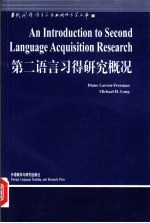图书介绍
第二语言习得研究概况2025|PDF|Epub|mobi|kindle电子书版本百度云盘下载

- (英)DianeLarsen-Freeman,(英)MichaelH.Long著蒋祖康导读 著
- 出版社: 北京:外语教学与研究出版社
- ISBN:7560020100
- 出版时间:2000
- 标注页数:403页
- 文件大小:19MB
- 文件页数:444页
- 主题词:第二语言-研究-英文
PDF下载
下载说明
第二语言习得研究概况PDF格式电子书版下载
下载的文件为RAR压缩包。需要使用解压软件进行解压得到PDF格式图书。建议使用BT下载工具Free Download Manager进行下载,简称FDM(免费,没有广告,支持多平台)。本站资源全部打包为BT种子。所以需要使用专业的BT下载软件进行下载。如BitComet qBittorrent uTorrent等BT下载工具。迅雷目前由于本站不是热门资源。不推荐使用!后期资源热门了。安装了迅雷也可以迅雷进行下载!
(文件页数 要大于 标注页数,上中下等多册电子书除外)
注意:本站所有压缩包均有解压码: 点击下载压缩包解压工具
图书目录
1 Introduction1
1.1 The place of second language in the world today1
1.2 Why study second language acquisition?2
1.3 Development ofthe field of study ofsecond language acquisition5
1.4 The scope ofsecond language acquisition research6
Notes7
Activities8
Suggestions for further reading9
2 Second language acquisition research methodology10
2.2 Qualitative versus quantitative methodologies10
2.1 Introduction10
Preface by Hallday11
Contents11
王宗炎序12
2.2.1 Introspection15
2.2.2 Participant observation15
导读15
2.2.3 Non-participant observation16
2.2.4 Focused description17
2.2.5 Pre-experiment19
2.2.6 Quasi-experiment20
2.2.7 Experiment20
2.3 Setting24
2.4 Instrumentation:production data elicitation26
2.5 Variability problem30
2.6 Instrumentation:intuitional data elicitation33
2.7 Instrumentation:use ofminiature languages35
2.8 Instrumentation:affective variables35
General Editor's Preface36
2.9 Instruments from other disciplines37
2.10 Measuring learner performance38
2.10.1 Defining language proficiency38
Authors'Preface F39
2.10.2 Defining an acquisition point40
2.10.3 Task versus test41
2.10.4 An index ofdevelopment42
Acknowledgements42
2.11 Conclusion44
Notes45
Activities46
Suggestionsforfurther reading50
3 SLA:Typesofdataanalysis52
3.1 Introduction52
3.2 Contrastiveanalysis52
3.2.1 The contrastive analysis hypothesis53
3.2.2 Language acquisition as habit formation55
3.2.3 The CAH refuted55
3.3 Erroranalysis56
3.3.1 Strong versus weak versions of the CAH56
3.3.2 Language acquisition as rule formation57
3.3.3 Interlingual versus intralingual errors58
3.3.4 Interlanguage60
3.3.5 Erroranalysis criticized61
3.4 Performanceanalysis62
3.4.1 Morpheme studies62
3.4.2 Developmental sequence63
3.4.3 Learner strategies65
3.4.4 The acquisition offorms and functions68
3.4.5 Formulaic utterances68
3.5 Discourseanalysis69
3.5.1 Conversational analysis70
3.5.2 Other applications ofdiscourse analysis71
3.6 Conclusion73
Notes74
Activities75
Suggestionsforfurtherreading80
4.2 ILs vary systematically81
4.2.1 Freevariation81
4.1 Introduction81
4 Interlanguage studies:Substantive findings81
4.2.2 Systematic variability82
4.2.3 Variability resulting from amount of attention84
4.2.4 Free variation as an impetus for development85
4.2.5 Multiple explanations for variability86
4.3 ILs exhibit common acquisition orders and developmental sequences88
4.3.1 Acquisition order:morpheme studies88
4.3.2 Developmental sequence:interrogatives92
4.3.3 Developmental sequence:negation94
4.4 ILs are influenced by the learner's L196
4.4.1 The effect of the L1 on SLA:how97
4.4.2 The effect of the L1 on SLA:when(markedness)101
4.4.3 The effect of the L1 on SLA:when(perceived transferability)103
Notes107
Activities108
Suggestions for further reading112
5 The linguistic environment for language acquisition114
5.1 Linguistic input for first language acquisition114
5.2 Linguistic input for second language acquisition116
5.2.1 Linguistic adjustments to non-native speakers117
5.2.2 Conversational adjustments to non-native speakers120
5.3 Does the linguistic environment make a difference?128
5.3.1 The effect of deviant input129
5.3.2 The role of conversation in developing syntax130
5.3.3 Input frequency-accuracy order relationships132
5.3.4 Input modification and second language comprehension134
5.3.5 Comprehensible input and second language acquisition139
Notes144
Activities145
Suggestions for further reading152
6.1 Introduction153
6 Explanations for differential success among second language learners153
6.2 Age154
6.2.1 Studies of age and SLA155
6.2.2 Explanations for age-related differences163
6.3 Aptitude167
6.4 Social-psychological factors172
6.4.1 Motivation173
6.4.2 Attitude175
6.5 Personality184
6.6 Cognitive style192
6.7 Hemisphere specialization197
6.8 Learning strategies199
6.9 Otherfactors203
6.10 Conclusion206
Notes215
Activities216
Suggestions for further reading218
7 Theories in second language acquisition220
7.1 Introduction220
7.2.1 The role oftheories in making research cumulative221
7.2 Theory construction and social science221
7.2.2 Purposes and types oftheory222
7.3 Nativist theories ofSLA227
7.3.1 General characteristics227
7.3.2 Chomsky's Universal Grammar and SLA228
7.3.3 A critique of language-specific nativist theories235
7.3.4 Krashen's Monitor Theory240
7.3.5 A critique ofMonitor Theory245
7.4.1 General characteristics249
7.4 Environmentalist theories of SLA249
7.4.2 Schumann's Pidginization Hypothesis and Acculturation Model251
7.4.3 A critique of the Pidginization Hypothesis and Acculturation Model258
7.5 Interactionist theories of SLA266
7.5.1 General characteristics266
7.5.2 Givon's Functional-Typological Theory and SLA267
7.5.3 A critique ofGivon's theory in SLA research269
7.5.4 The ZISA's group's Multidimensional Model270
7.5.5 A critique ofthe Multidimensional Model283
7.6 Conclusion:the state of SLA theories287
7.6.1 Comparing and evaluating theories287
7.6.2 A note of caution289
Notes290
Activities293
Suggestions for further reading296
8 Instructed second language acquisition299
8.1 Introduction299
8.2 Early research on the effect ofinstruction,and some claimed implications300
8.3 The effect of instruction on accuracy orders and developmental sequences304
8.4 The effect of instruction on acquisition processes309
8.5 The effect of instruction on rate ofacquisition312
8.6 The effect of instruction on the level ofultimate SL attainment315
8.7 Conclusion321
8.8 Explanations322
8.9 Researching instructional design features325
Notes327
Activities328
Suggestions for further reading330
Epilogue332
Bibliography334
Index394
文库索引399
热门推荐
- 1693988.html
- 3901701.html
- 652955.html
- 659405.html
- 2244558.html
- 192251.html
- 1100011.html
- 813505.html
- 1640915.html
- 1136246.html
- http://www.ickdjs.cc/book_2509041.html
- http://www.ickdjs.cc/book_3490245.html
- http://www.ickdjs.cc/book_3615759.html
- http://www.ickdjs.cc/book_3492268.html
- http://www.ickdjs.cc/book_782929.html
- http://www.ickdjs.cc/book_1684758.html
- http://www.ickdjs.cc/book_1420012.html
- http://www.ickdjs.cc/book_2272017.html
- http://www.ickdjs.cc/book_86330.html
- http://www.ickdjs.cc/book_3424655.html